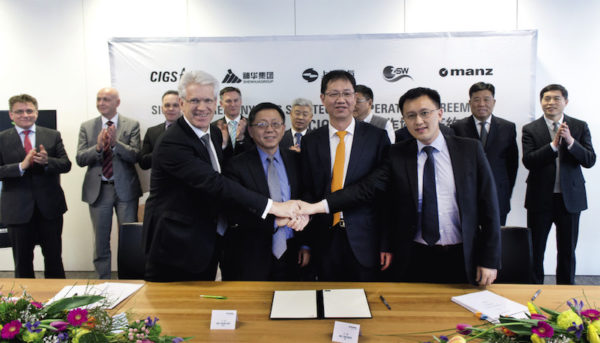Shanghai Electric’s recent €263 million purchase of CIGS thin-film PV production equipment from Manz AG was a sorely needed win for the beleaguered German tool manufacturer.
CEO Dieter Manz — who led a years-long struggle to commercialize the company’s turnkey production lines for copper indium gallium selenide (CIGS) thin-film solar modules — sounded relieved in January when he hailed the deal as a “breakthrough.”
Manz says that it is still on track to deliver a 44 MW R&D line and a 306 MW commercial production line to Shanghai Electric and its partner, state-owned power group Shenhua Group, by the end of 2019. Axel Bartmann, head of marketing and corporate communications for Manz, says that much of the heavy lifting for the fab will be done over the course of the coming year.
However, while much has been said in recent months about how the sale of the two CIGSfab lines has served as a clear vindication of the Reutlingen-based company’s focus on thin-film technology, the motivations and future plans of Shenhua and Shanghai Electric — which itself is a listed subsidiary of state-owned power giant State Power Investment Corp. — remain less clear. That is largely because the two Chinese companies, as not very transparent state-owned enterprises (SOEs), have been predictably tight-lipped about their deal with Manz.
“They’re convinced that it’s a future potential technology,” says Bartmann, claiming that the two Chinese companies are eager to differentiate themselves from other energy suppliers in the country. “Now with this leading technology, they can speed up the further development with us. And that forms the basis of their business model in China.”
R&D focus
In the immediate term, NICE PV Research — the new German-Chinese joint venture that has absorbed the now-defunct Manz CIGS Technology GmbH — says it is already pushing ahead with an R&D roadmap.
AT A GLANCE
- Early in 2017, Shanghai Electric purchased €263 million of CIGS thin-film production equipment from German supplier Manz AG.
- Together with the Shenhua Group they have also formed a joint R&D venture named NICE PV Research, and set out a roadmap to reach higher efficiencies with CIGS technology.
- Shanghai Electric has remained tight lipped about the deal. However, analysts believe pressure from the Chinese state to consolidate operations and move into new technologies could be at the heart of the deal.
- Shanghai Electric may also be targeting CIGS for its future potential in areas such as building- and vehicle-integrated PV.
“I don’t think that in 10 years they will still want to have the R&D center,” says Smart Solar Consulting CEO Götz Fischbeck, arguing that Shanghai Electric and Shenhua face an enormous challenge as new entrants into the CIGS thin film space. “One has to admit that improvements in efficiency seen at the CIGS level on the production-scale module side haven’t been the same as what the crystalline silicon side has reached over the past three years.”

Fischbeck notes that while much of the research is being conducted in Germany, the Chinese side will ultimately want to ensure that this competency gets transferred to them. “[They] wanted to make sure that they were not left out in the cold on this technology,” he explains. “So there has also been significant political encouragement to take this risk.”
Michael Powalla — a member of the board of the Centre for Solar Energy and Hydrogen Research (ZSW) in Baden-Württemberg, which is a partner of Manz — says that NICE PV Research has already charted a clear path to achieving efficiency gains. Those improvements will then be transferred to the pilot phase, with the goal of eventually incorporating them into mass production.

“There are a lot of things we are working on. And to be honest, it’s an ongoing discussion which started in the spring,” Powalla says. “Where the low-hanging fruit is, what the long-term issues are —the overall goal in the development is to make CIGS cheaper. This means enhancing efficiency, making the processes faster and increasing throughput.”
Government pressure
However, R&D is just the tip of the iceberg. Manz says that Shanghai Electric has the entire CIGS value chain in its sights, from research to making PV modules and selling electricity.
“It makes a lot of sense to invest in thin-film technology,” Bartmann argues. “The investment barriers are not as high as if you’d invest in crystalline technology, where you have to go way bigger than for CIGS in order to be able to operate a production line profitably.”
Powalla at ZSW agrees that it will be much easier for Shanghai Electric and Shenhua to fully exploit the value of solar with CIGS technology than with silicon. And he believes that the two companies see solar as an important area for future expansion.
“They know that they have to replace coal electricity step by step. They see that PV is one of the pillars of the future of the electricity supply,” he says. “They also want, as utilities, to run big PV plants with the goal of replacing coal-fired electricity. And at the end they want to enter the gigawatt range.”
Patrick Dai, general manager for Macquarie Investment Consulting (Shanghai Co.), agrees that demand for coal-fired equipment — a key business for Shanghai Electric and Shenhua — will continue to dwindle in years to come. In August, for example, the Chinese government announced plans to halt the construction of 150 GW of coal-fired generation capacity through the end of the current decade.
Dai also agrees with Fischbeck’s contention that the two Chinese groups, as SOEs, are under tremendous pressure from the central government to consolidate their operations, whether vertically or horizontally, in order to reduce excess capacity and improve their competitiveness. In addition, he notes that Beijing is encouraging such companies to start to acquire new technologies — even those that lie beyond the scope of their traditional businesses. And with that in mind, he argues that Manz likely looked like a bargain for Shanghai Electric and Shenhua, given their deep pockets.
“So it’s not really a big surprise to me that Shanghai Electric acquired a high-technology equipment manufacturing business that is still within the power sector but in a different area,” Dai explains, describing its foray into thin-film PV as a “necessary move” as it continues to diversify.
Transportation tech
However, Dai does not believe that the company’s long-term CIGS ambitions are solely limited to large-scale power generation and electricity sales. “Shanghai Electric is working vigorously to diversify their products,” he explains. “They are still trying to think about what other businesses they can do.”
Dai is broadly pessimistic about the prospects for the widespread deployment of thin-film solar modules in large PV projects in China, which is partly why he believes that Shanghai Electric is looking beyond simply using panels in big installations. Among other factors, he argues that Hanergy’s widely publicized problems in recent years have played a role in dampening demand for thin-film PV modules among Chinese developers.
Rather, Dai thinks that Shanghai Electric and Shenhua are evaluating a broad range of potential applications for CIGS technology, including BIPV solutions. He also believes that the two companies may be eyeing longer-term opportunities, such as the potential to integrate thin-film solar technologies into drones and planes.
Dai adds that mobility and transportation in general will likely be key areas of consideration for Shanghai Electric and Shenhua, in large part because China is already a leader in electric-vehicle (EV) production. The country accounted for 43% of global EV production in 2016, according to a recent report by McKinsey & Co.
“Thin film can be a supplementary source of electricity for vehicles, at a relatively low cost,” Dai says. “However, these are not mature areas, but still developing.”
He also believes that Shanghai Electric and Shenhua may be interested in eventually integrating CIGS technology into EV charging stations. “I think they’d want to be the operators of the charging facilities,” he speculates. “But it’s just too early, because none of these have been proven by a commercial business model yet — it’s just a starting point.” S
This content is protected by copyright and may not be reused. If you want to cooperate with us and would like to reuse some of our content, please contact: editors@pv-magazine.com.
